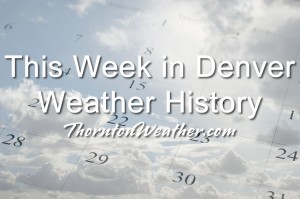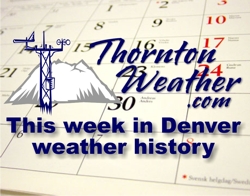
Christmas Day is normally a relatively quiet day in terms of the weather as we recently discussed but the week between it and New Year’s can be quite eventful. Among the highlights are a prolonged period of sub-zero temperatures that lasted nearly five days. Just five years ago a blizzard struck the region that snarled holiday travel on the air and the ground.
From the National Weather Service:
20-25
In 1983…an extremely bitter cold spell occurred. The temperature remained below zero for 115 hours in Denver… The longest sub-zero period on record. The mercury dipped to 21 degrees below zero on the 21st…the coldest recorded temperature in over 20 years. The cold was accompanied by winds that plunged chill factors to 50 to 70 degrees below zero. Two people froze to death in Denver; both were found outside dead of exposure. Numerous cases of frostbite were reported. Hundreds of water pipes broke from the intense cold…water mains and natural gas lines also fractured…and electricity consumption reached record levels. Light snow totaling 5.8 inches fell at times…and holiday traffic was delayed at Stapleton International Airport for several hours. Eight daily temperature records were set at the time. The all-time record low maximum temperature for the month of 8 degrees below zero on the 21st still stands today. Other temperature records still standing include record low maximum temperatures of 5 degrees below zero on both the 22nd and 23rd and 4 degrees below zero on the 24th.
24-25
In 1891…heavy snowfall of 7.0 inches in downtown Denver provided a white Christmas. Most of the snow…6.5 inches… Fell on the 24th. Northwest winds were sustained to 30 mph with gusts to 40 mph on the 24th.
In 1894…snow began falling during the evening of the 24th… Ended during the early afternoon of the 25th…and totaled 6.4 inches in downtown Denver. Northwest winds were sustained to 26 mph with gusts to 30 mph on the 24th. The maximum snow depth on the ground was 5 inches. The high temperature was only 18 degrees on the 25th after a low of 8 degrees.
In 1980…strong Chinook winds of 50 to 60 mph occurred in the foothills with a wind gust to 90 mph recorded at Wondervu. West winds gusted to 33 mph at Stapleton International Airport on the 25th.
In 1997…a relatively rare Christmas snowstorm blanketed much of northeastern Colorado. Snowfall in and near the Front Range foothills and south of metro Denver ranged from 5 to 8 inches. Elsewhere…new snow accumulations were generally 1 to 3 inches. Snowfall totaled only 1.5 inches at the site of the former Stapleton International Airport. North winds gusted to 29 mph at Denver International Airport on the 24th.
25
In 1873…northwest winds were sustained to 36 mph during the morning and to 48 mph in the evening. The Chinook winds warmed the temperature to a high of 53 degrees.
In 1883…gusty very strong winds raked Boulder…causing 11 hundred dollars in damage.
In 1985…Table Mesa in Boulder was buffeted by wind gusts to 68 mph.
In 1993…occasional high winds occurred over portions of the higher foothills west of Boulder and Denver. A wind gust to 87 mph was recorded on squaw mountain…and a gust to 83 mph occurred at Rollinsville. Northwest winds gusted to 35 mph at Stapleton International Airport.
In 2007…a winter storm brought heavy snow to the Front Range of Colorado. The heaviest snow fell near the foothills of Boulder…Douglas and Jefferson counties. The snow caused accidents throughout the Denver metropolitan area. Gusty winds produced snow drifts from 2 to 3.5 feet in depth. Total snowfall for the calendar day in Denver was 7.8 inches…setting a new record for Christmas Day. The measurement was taken at the former Stapleton International Airport; the previous record was 6.2 inches… Set in 1894. Storm totals in the Front Range foothills included: 13.5 inches at Coal Creek Canyon; 12 inches…5 miles east-southeast of Aspen Park; 11 inches; 6 miles southwest of kassler; 10.5 inches at Eldorado Springs. Elsewhere…storm totals ranged from 5 to 10 inches. In the urban corridor storm totals included: 9 inches near Elizabeth; 8 inches in southwest Denver…Highlands Ranch…Marston Reservoir and Wheat Ridge; 7.5 inches in Arvada; 7 inches in Centennial and Lakewood; 6.5 inches in Aurora and 8 miles southeast of Watkins; 6 inches in Boulder…Englewood and Parker. Elsewhere…storm totals ranged from 3 to 5 inches.
25-26
In 1904…after a warm Christmas Fay with a high temperature of 50 degrees…a late day cold front plunged temperatures to a low of 7 degrees…produced northeast winds sustained to 40 mph with gusts to 54 mph…and produced 5.2 inches of snow overnight for a late white Christmas. The maximum temperature on the 26th was only 16 degrees.
25-31 in 1980…temperatures were unusually warm during the week between Christmas and New Year’s. High temperatures for the week ranged from the mid-50’s to the mid-70’s. Four temperature records were set. Record highs occurred on the 26th with 68 degrees…the 27th with 75 degrees…and the 30th with 71 degrees. A record high minimum temperature of 41 degrees occurred on the 27th.
Continue reading December 25 to December 31 – This Week in Denver Weather History

